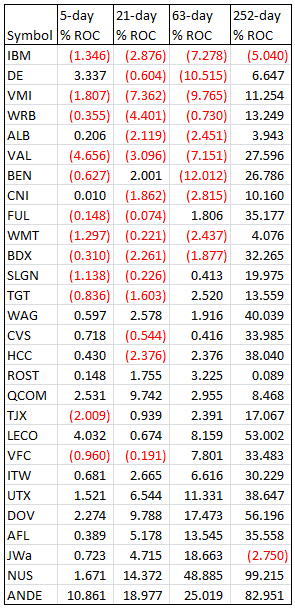28 Stock Selections From Reverse Engineered Stock Analyst Ratings
Post on: 15 Июль, 2015 No Comment

There are many popular and academic articles and reports on what quantitative metrics make for good stock picks — that’s theory. How in practice do professional stock analysts actually utilize key metrics in making their Bull/Bear or Buy/Hold/Sell ratings? What does that tell us about possible stock choices today?
Beyond a current list of stock selection prospects for your further research, this article aims at providing some take-away information that could aid you in future research while providing some comfort that the criteria are embraced by the professional analyst community in general.
We did an informal reverse engineering of analyst ratings today to see what makes those analysts rate as they do. We looked at 11 popular quantitative criteria to find the levels within those criteria that garnered the largest percentage of bullish analyst ratings.
The analysts we used are the ThompsonReuters StarMine analysts as provided through Fidelity. Those analysts are the ones that ThompsonReuters determines have issued ratings that best correlate with subsequent stock performance in each sector.
The result of that work were 110 stocks, to which we added a requirement that dividends had not been decreased in any of the past 10 years, to arrive at these quantitative stock selections. You need to go into further investigation to see what may work for you, and to assess other quantitative and qualitative factors, but this is a nice list to focus research efforts.
CRITERIA EVALUATED
The criteria we examined were:
- market-cap size
- whether the stock pays a dividend or not
- current yield among dividend paying stocks
- 5-year dividend growth rate among dividend paying stocks
- dividend coverage (earnings / dividends)
- 1-year Beta (degree of price reaction to changes in price of S&P 500)
- return on equity (ROE)
- 3-year revenue growth rate
- 5-year projected earnings growth rate
- estimated P/E (price divided by next year’s estimated earnings)
- PEG Ratio (estimated P/E dividend by 5-yr proj. earnings growth rate)
We also looked at the analysts’ ratings relative to:
- earnings and dividend quality rating by Standard and Poor’s Capital IQ
- price relative to fair value rating by Standard and Poor’s Capital IQ
OVERALL BULLISH RATINGS
As of August 13, 2013, there were 2,348 stocks with a market-cap of $1 billion or more, and a price of $5 or more. Of those 568 (24.2%) were rated Bullish or better by ThompsonReuters Starmine.
This covered almost all of the total market-cap of the stock market. While there are over 7,000 stocks available in US markets, most are insignificant. There are 4,577 with a price of $5 or more, and 7,369 with a price of $0.01 or more, but on balance they simply don’t matter to any market level study.
HURDLE RATING FOR CRITERIA EVALUATION
For the purpose of this review, we looked for levels within each of the 11 popular metrics that garnered more than the 24.2% bullish rating for the market overall.
RESULTS (levels above the 24.2% hurdle rate)
Details for these results are shown in color coded tables below. These are the preferred levels by each of the 11 criteria according to ratings assigned by analysts:

- Large-cap
- Dividend payers
- Dividend yield from 0.01% to 2.5%
- 5-yr dividend growth rates of 7% or more *
- Dividend coverage of 2x or more
- 1-yr Beta from negative to 2.5x (with preference for >1x)
- ROE of 10% or more
- Revenue Growth — most rates favored except for extremes
- Projected Earnings Growth — most rates favored except for extremes
- Estimated P/E ratios of 17x or less are favored
- PEG Ratio — preference for 0.5x to 2.0x (but above hurdle to 3.5x) **
* The dividend growth rate does not show consistent analyst choices below 7% growth. Stocks with declining dividend growth attract significant attention, as do those with 4% to 6% growth, However, above 7% growth the analyst preference is clear and strong.
** PEG Ratio does not apply to equity REITs or pipelines, which have very high depreciation rates and intentionally low reported earnings. They need to be judged on other measures dealing with distributable cash and tax shelter.
RATING ASSIGNED FOR S&P QUALITY AND FAIR VALUE
- Quality: B (slightly below average) or better beats hurdle, with strong preference for A+
- Fair Value: all but 1 (significantly overvalued) beat hurdle, with strong preference for 4 and 5 (moderately undervalued and significantly undervalued)
Figure 1: Market-Cap
Figure 2: Dividends or No Dividends
Figure 3: Current Yield
Figure 4: 5-Year Dividend Growth Rate
Figure 5: Dividend Coverage
Figure 6: 1-Year Beta
Figure 7: ROE
Figure 8: 3-Year Revenue Growth Rate
Figure 9: 5-Year Projected Earnings Growth Rate
Figure 10: Estimated P/E
Figure 11: PEG Ratio
Figure 12: S&P Earnings and Dividend Quality
Figure 13: S&P Fair Value
STOCKS PASSING SIMULATION OF ANALYST CHOICES
Based on the analyst preferences evidenced in the tables above, we conducted a filter using those criteria with clear preferences. These are the criteria:
- Large-cap
- Dividend paying
- Yield 0.1% to 2.5%
- 5-yr dividend growth rate 7% or more
- Dividend coverage of 2x or more
- 1-year Beta of 2.5 or less
- ROE of 10% or more
- Estimated P/E of 17x or less
- PEG Ratio of 0.5 to 2.0
There were 54 stocks that passed. However, there are good mid-cap and small-cap stocks. By eliminating the large-cap requirement, 110 stocks passed.
ADDING OUR SPECIAL SAUCE
Because we think consistency in dividend payments (whether the yield is high or low) is an important indicator of overall economic growth and health, we require that dividends be paid and not decreased in any year for at least 5 years. Because so many companies cut dividends in the 2008-2009, we prefer to require that dividends have been paid and not decreased in any year for at least 10 years to cover that difficult period.
That data is provided by David Fish at www.dripinvesting.com .
Because of the special dividends paid at the end of 2012 (and at some other times for some companies), it is necessary to filter out those specials to see the underlying trend. We have not done that inspection at this point, and are relying on David Fish’s work — you should do your own corroboration.
By adding our dividend persistency/consistency criterion, the 110 stocks were decreased to 28. Those stocks are:














